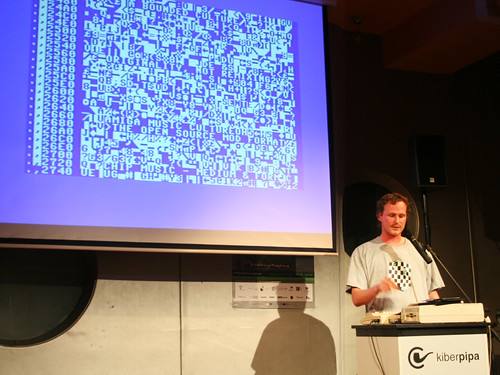A while ago I went to Ljubljana in Slovenia, for the HAIP Festival. It is a festival about open hard- and software, music and art. There were lectures, performances, exhibitions, and a special club night with chip music. The boys made the music (Binärpilot, me, and Nova deViator) and the girls made the visuals (Rosa Menkman, Raquel Meyers, Delta Nu, and Mina Fina). There were some interesting lectures and performances, for example Rosa’s glitch talk (which I missed), Piratebay and Piratbyrån’s S23X (which I missed), Monochrom‘s sculpture mobs, and Frey and Christine Sugrue’s A Cable Plays (which I missed). Note to self: things are more interesting if you miss them.
Well, I had a talk about 8-bit demoscene and chip music in relation to open source, hacking, and remixing. (world record in buzz words?) Instead of using the almighty Powerpoint, I used a ‘machine code monitor’ which is a textual representation of the 64 kilobyte of the C64 – from 0 to 65535 (or in hex number: 0 to FFFF). So I was scrolling through the memory to show the main points of my presentation. I’ll just give you a rough idea of what I talked about: the illegal heritage (cracking), aesthetics of demos (craftmanship not art, competitive not conceptual, trial and error), geography & sociology (mainly middle-class boys in OECD-countries, except Japan), bounded culture (internal community not reaching out, not getting attention), and the importance of originality (distribution forms good for ‘remixing’, but norms of originality prevailed).
After this somewhat subjective explanation of the multifacetted demoscene culture, I focused more on music. The sample-based music format MOD was used extensively on the Amiga in the 1990s. It was open source by default – distributing your music (in a demo, game, or independently) meant sharing your ‘source’ (inclduing sasmples). MOD composers would sample sounds from records, movies, etc, and claim ownership of them. Using someone else’s samples was more or less ‘lame’. Everything indicates that the term chipmusic/chiptune was first used in the Amiga demoscene around 1990 to describe bleepy MOD music (based on tiny samples). Fast forward to 2003, and enter ‘8-bit punk’: gameboys, reverse engineering, anti-commercialism. Demosceners are sceptic, seeing it as bad craftmanship, lack of novelty, and a sort of invasion to their bounded culture which had born and raised chip music. Then I explained what I mean with medium & form to finally return to copyright and remixing again. The demoscene grew out of cracking, and has similar a similar way of disrespecting ‘external’ copyright but staying true to ‘internal’ copyright-norms. When Timbaland sampled a whole song from the demoscene, the ‘nerd army’ of the demoscene probably contributed a lot to the media hype that followed. Reality is catching up with the demoscene, and reality needs to watch out.


photos:r00s
On the left is me and my Superpowerpoint™, and on the right is the glitch monument from outer hell, made by Autoboy and me. Here it is in Copenhagen last spring at re:new. It was also exhibited at Mikrogalleriet and now I took it to Slovenia! It is called HT Gold and is 1) a C64-game for two players that is a lot of fun, and has no bugs 2) a result of complex disassembly and analysis, to intentionally change specific details like steering, physics, graphics, and sound of the game Hat Trick, 3) machinima, glitch art, datatrash, detournemant, and a modulation from game to play since the scoring board has been glitched. Theory, images, and video found here. The video looks blurry compared to the original though. Does anybody have a possibility to record video in 50 progressive frames per second? That’s apparently what it takes to be able to record HT Gold. It’s too fast for emulators, recorders, codecs, and other silly inventions, hehe.
November 25, 2008 at 7:15 pm |
Buzzword soup!
I would like to attend a lecture like this ;D
I guess we have to bring you down south! ;)
November 25, 2008 at 8:55 pm |
yep same here, sounded really cool festival ! do you plan to publish a text file of your lecture on the net ?
http://www.scheib.net/play/demos/what/borzyskowski/ found this some years ago, report from 92-94 on amiga scene ! dope but no chiptunez buzzwords :’/ ?
November 25, 2008 at 11:00 pm |
glad u liked it!
@akira: i’m all ears :)
@otro: yep, i will publish some kind of text from this. it was really interesting to do the talk, because i noticed some things i forgot, and what things to expand on. i’ll be back! …. and yep, i saw that borzyskowki-text before, it’s quite impressive! but mine will of course be better hehehe.
December 18, 2008 at 9:52 pm |
oh fuck, missed you speech! but note to myself: it’s always more interesting when you miss it. seriously: ‘sthere a video out there?? anyone??
February 6, 2012 at 9:10 am |
[…] a bit funny. I’ve argued before that demos are works of craft, not art. Demos are made for showing off and winning a compo. […]
November 18, 2013 at 7:20 pm |
[…] than the concept, which connects to scene to craft rather than art. I’ve emphasized this since 2008, because it’s one of the most defining traits of the scene […]